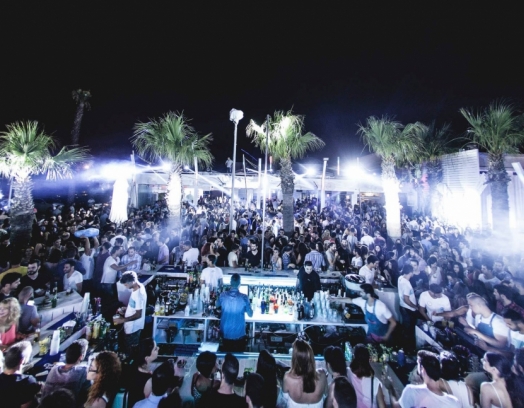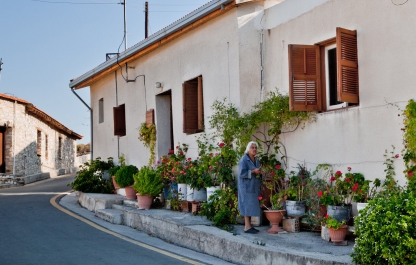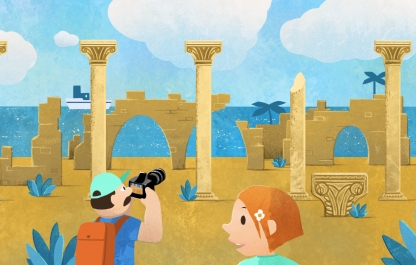Saint Minas is one of the most revered warriors in Cyprus, alongside figures like St. George, Theodore the Tyro, Demetrius of Thessaloniki and St. Theodore Stratelates. In addition to that, Minas was thought to possess healing powers. Legend has it that during the rule of Emperor Diocletian, the saint was enrolled in the army. When he was ordered to head to Northern Africa together with other warriors to fight local Christians, Minas left the army and moved to the mountains to live alone.
One day Minas came to the city to preach and to condemn paganism, for which he was arrested and sent to jail. There he was subjected to brutal torture for his refusal to return to the practice of paganism. He withstood the beating, but was executed. After his body was burned, Christians took his remains to Alexandria, where they were kept in a church dedicated to the Saint.
Historians are unsure about the exact date when the monastery was founded, but they do know that the first mention of it was made in the Paris Codex of 1562. The only thing that these records do state is that the monastery was established in the 17th century.
The monastery also has a gospel published in Venice in 1606. The gospel includes numerous notes written in the period of 1698-1610 by the monastery’s inhabitants about its everyday life.
In 1727 the Archdiocese of Cyprus had detailed recordings of the monastery’s list of possessions, while the Russian monk and traveler Vasily Grigorovich-Barsky, who visited the retreat in 1734, had described the monastery and the miracle-working icon of St. Minas in his travel diaries. Thanks to these bits and pieces of information, we have substantial documentary evidence about the monastery’s existence during the 16th-18th centuries.
At the end of the 19th century an alternative theory about the monastery’s founding had emerged. French archeologist Camille Enlart suggested that the monastery was built in the 15th century by the Dominican Order. Enlart also identified the monastery as that of St. Epiphanius. There is no documentary evidence to support this claim. To the contrary, the fact that the monastery church was erected only in the 18th century — contradicts the archeologist’s claim.
Unfortunately, the icon of St. Minas, which was thought to possess miracle-working powers, has been lost irretrievably.
By the middle of the 18th century things at the almost empty monastery were starting to improve: dilapidated buildings had been restored and a new church had been erected and decorated with fine frescoes and a carved iconostasis. These changes date back to 1754 — a year that is indicated at the southern entrance into the church. Another sign — located on the eastern wall of the church — dates back to 1760 and reveals the fact that during the said period the monastery had its own olive oil processing facility and crafts workshops. These signs indicate that this was a prosperous time for the monastery.
The downfall came following the defeat of the liberation uprising of 1821. The event saw many of the clergy and secular people murdered, while the Archbishop of Cyprus was executed. By 1837 the monastery had become entirely abandoned and its buildings were rented out to farmers.
In 1965 a group of eight nuns moved there from St. Georgios Alamanou Monastery. Gradually, things started to get back on track. The nuns oversaw the restoration of the church, repaired the damaged cells and built new ones, planted flowers and started a fruit garden. By the end of the 20th century two new chapels had been constructed and dedicated to St. Ignatios and St. George as well as St. Stilian (a patron of infants and infertile women).
By the beginning of the 21st century the Monastery of St. Minas had become one of the largest in Cyprus. Thanks to the tall, imposing walls, which are reinforced with additional buttresses and include small windows that look like loopholes, the monastery resembles a medieval fortress.
The two-story buildings line the perimeter of the monastery. The main church is located in the center of the courtyard. It is a single-aisle basilica with an arcade on the northern and southern side. The gable roof is covered in tile, while the bell tower perfectly complements the entire ensemble.
Legend has it that the construction of the monastery was financed by a high-level bureaucrat from the Ottoman Empire, who had secretly converted to Christianity. Local residents call his alleged burial site the “Turk’s grave”.
The wooden three-tiered iconostasis, which dates back to the 18th century, is one of the church’s main treasures. The Festival and the Deesis tier on the altar gate are heavily gold-plated, while the Veneration tier has been left untouched. This is because the artist, who worked on it, was killed by burglars in the middle of his work. The gate was left unfinished in his memory.
Other church objects worth noting are the 18th century intricate pulpit, the wooden balcony decorated with floral patterns and the carved lectern.
The walls of the church have been decorated with frescoes. Their painter, Father Filaret, was a student at the iconography school of the Monastery of Saint Herakleidios. One of the frescoes shows St. Minas, the other one depicts St. George, while the third one, which is called “The Brink of Humility” — portrays the crucified Savior, His Passions and His tomb, where instead of lying down, Christ appears to be hanging on the Holy Cross.
Icon painter Ioannikiy, who just like Father Filaret lived in the middle of the 18th century, also worked on the images depicted on the altar gate. The image of St. Lazarus was created in 1778 by Father Leontiy, while the icon of the Virgin Hodegetria, which is located to the left of the Royal Doors, was painted in 1604 by a painter named Luka from the village of Tochni. The icon was first kept in a church located in Parsada. But in 1754 monks brought the image to the Monastery of St. Minas. However, this wasn’t the icon’s final stop. When the monastery ceased to function, the icon was moved to a local church in the village of Ora. Finally, one hundred years later the icon returned to the Monastery of St. Minas. However, the version shown in the iconostasis is merely a copy of the original.








